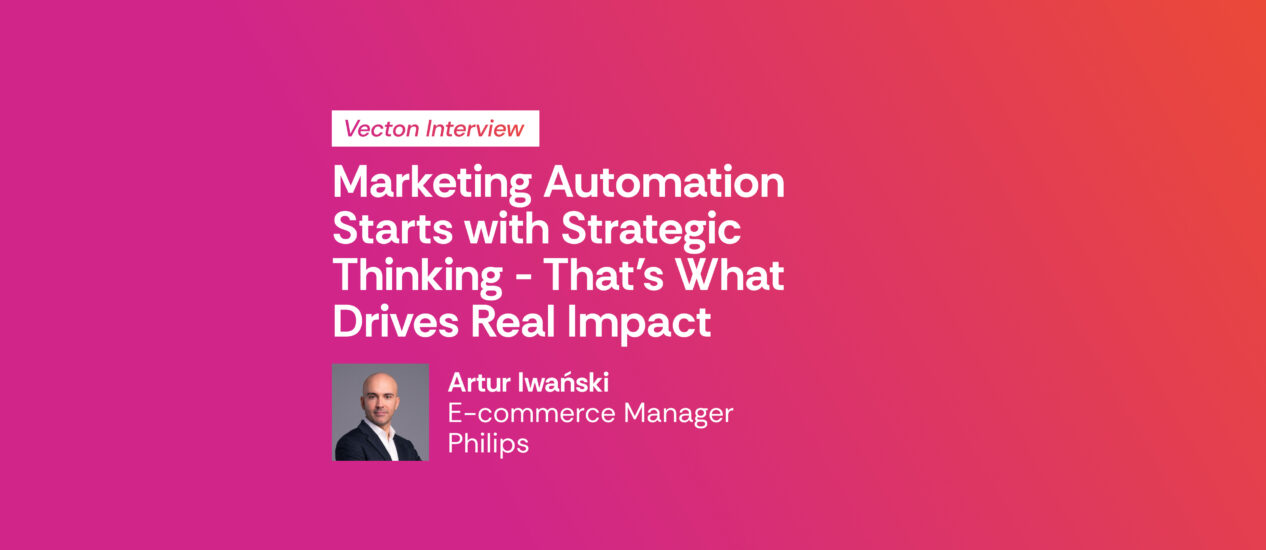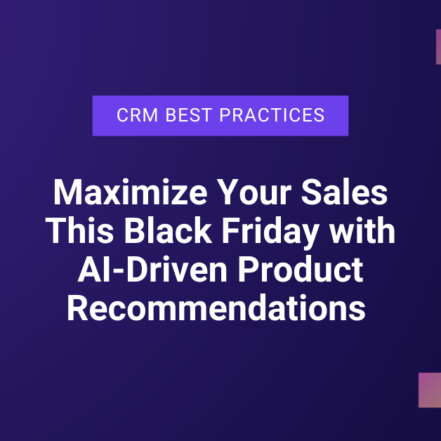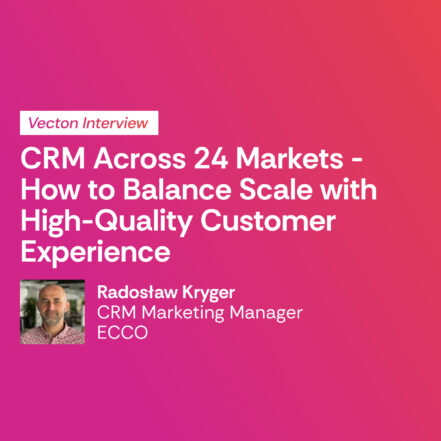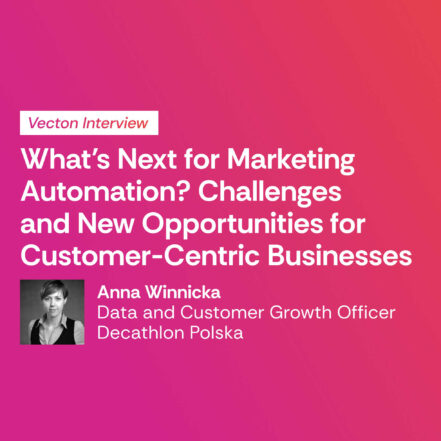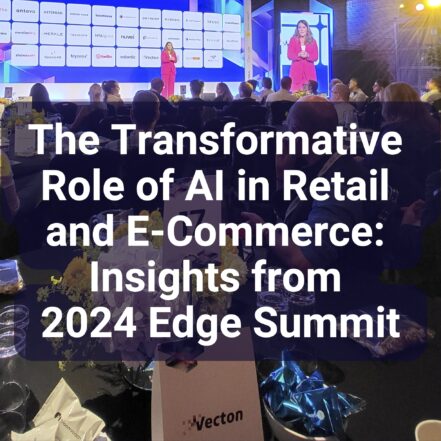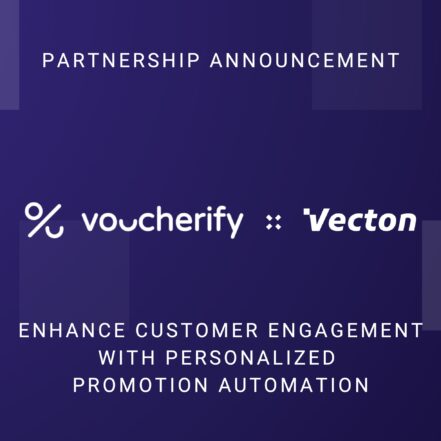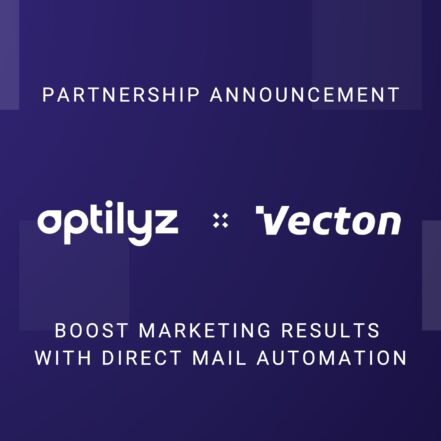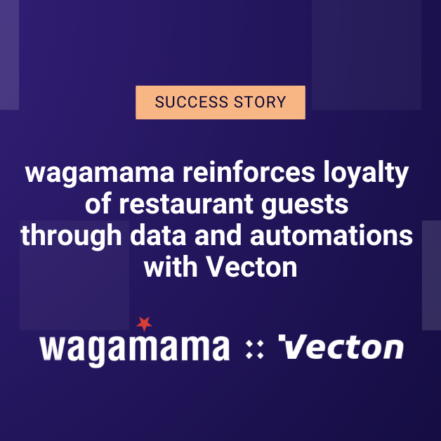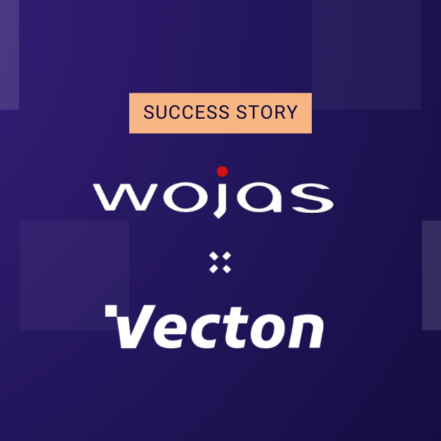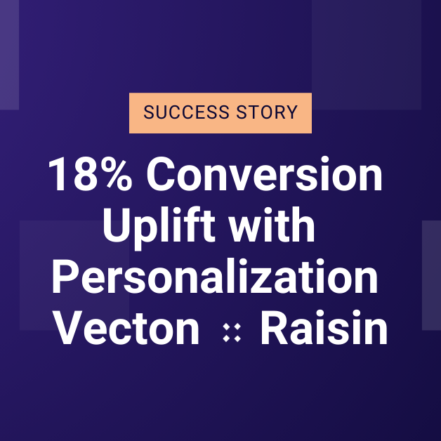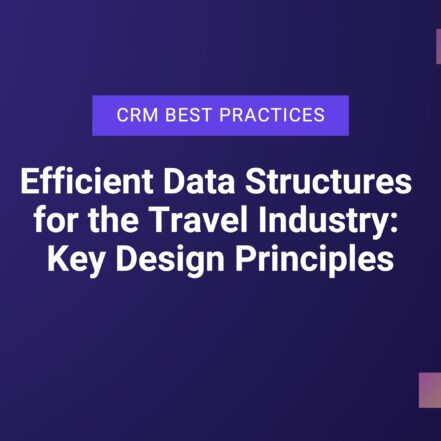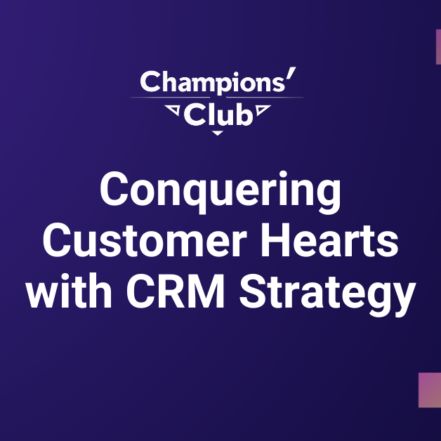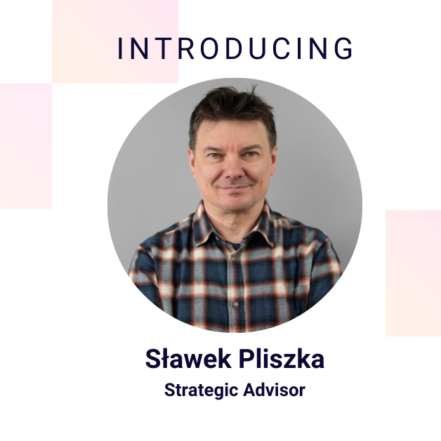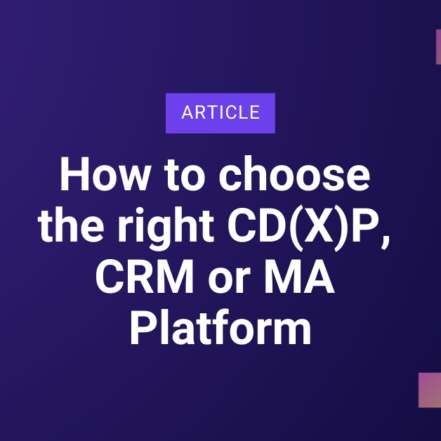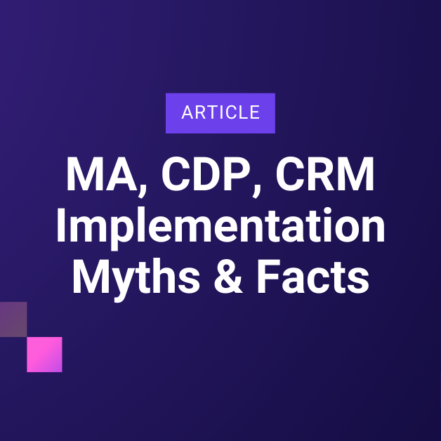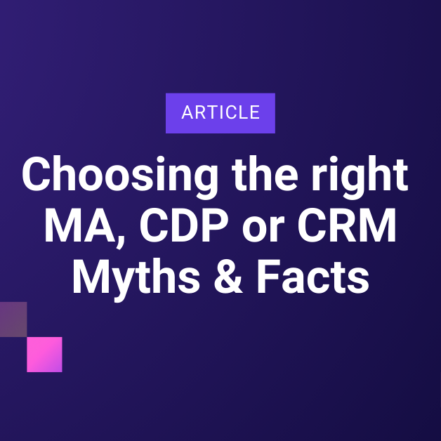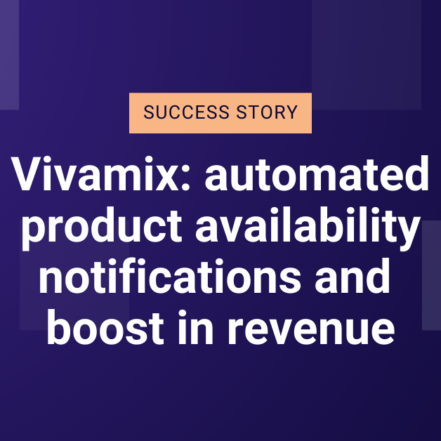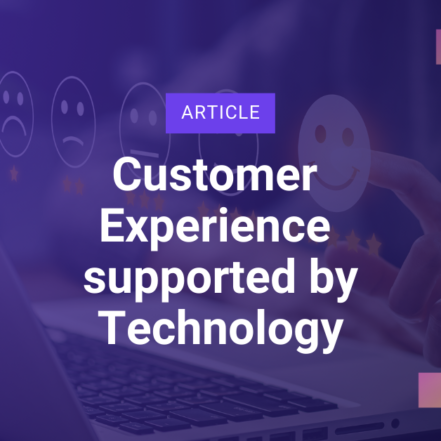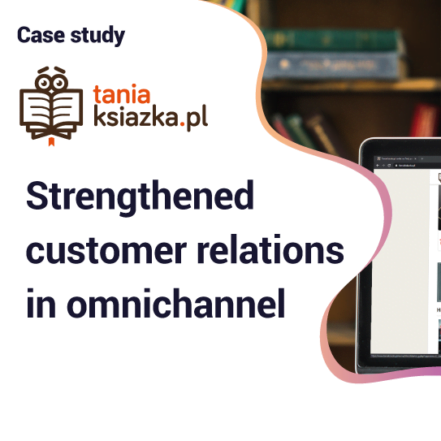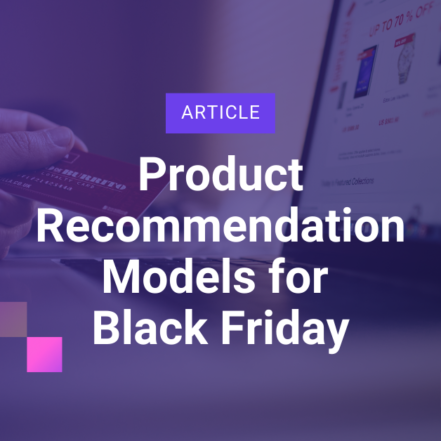Arek Kustra talks with Artur Iwański, E-commerce Manager at Philips, about the impact that personalisation and automation have on customer loyalty, sales and brand image.
Interview participants:

Artur Iwański – E-commerce Manager at Philips. Expert in D2C sales and brand-owned channel management. Currently, he is responsible for developing Philips Personal Health on-line store philips.pl. He successfully combines an analytical approach with a strong consumer focus, implementing e-commerce strategies that support long-term growth.

Arek Kustra – Founder and CEO of Vecton. Customer analytics expert and the head of Vecton, a CRM and Marketing Automation consulting agency. With 20 years of experience in market research, data analysis, and personalised marketing, he helps companies unlock the potential of CRM in their businesses.
Arek Kustra: To start, could you tell us about your current role at the company. What are your main responsibilities, and how do you engage with customer experience, personalisation, and automation?
Artur Iwański: Currently in the role of E-commerce Manager at Philips, I am responsible for our flagship store project, being part of our direct-to-consumer sales model where Philips offers its products directly to end customers, like you and me. Inside the organisation, we refer to our category as Personal Health, which includes Beauty, Male Grooming, Mother & Child Care and Oral Healthcare products.
When it comes to personalisation and Marketing Automation, from the perspective of my channel, which is the brand’s official online store, these tools are essential. Since we, as the official brand store, offer only products from a single manufacturer, we have full control over the user experience.
Personalisation and Marketing Automation are everyday tools for me, helping achieve not only sales goals but also brand image objectives. Of course, we are a sales channel, so we want to sell our products. However, a customer’s interaction with the brand starts much earlier, at the stage when users are just getting to know the brand, browsing products, and reading about their benefits and features. Only at that stage do customers decide where to complete their purchase, whether through our brand store or via one of our authorised partners.
As for the Marketing Automation tool itself, we use it at every stage of the funnel. From my perspective, overseeing sales through our brand-owned online store, I see broad opportunities to apply these solutions, not only at the lower stages of the funnel but also in driving brand awareness and customer engagement at earlier phases.
So it is fair to say that the potential of Marketing Automation spans the entire customer lifecycle, from the moment someone is not even thinking about making a purchase yet, all the way to when they are already a customer and return for more products.
You are now working at Philips, but previously you were responsible for E-commerce and Marketing Automation in other companies, using a variety of tools. From your perspective, how is the real potential of Marketing Automation being leveraged today in Poland, or more broadly in Europe? Are we fully utilising the technology we have? Are we approaching the limits of what is possible, or are we still far from reaching them?
The Western European markets, and particularly the American market, have been the pioneers in the use of Marketing Automation. This is where some of the most renowned personalisation cases originated, developed by companies such as Amazon, Zalando, and Netflix.
These organisations have set the standard, with the entire market observing and drawing inspiration from their practices. The availability of Marketing Automation solutions has improved significantly over time. Looking back at my first onboarding experiences seven or eight years ago, it was a period when access to plug-and-play solutions was extremely limited. Tools also required really technical, coding skills, and did not really operate on basic „what you see is what you get” principles, allowing simple configuration through user panels without the need for advanced implementation or programming expertise.
At that time, building Marketing Automation scenarios was possible but in a very limited capacity, far from the sophisticated implementations seen at companies like Amazon or Netflix. Today, the evolution of Marketing Automation technology is similar to the development of the Google Ads ecosystem. Running campaigns used to require deep technical expertise, manual optimisation, and the creation of complex structures. Now, platforms enable users to set budgets, upload visuals, and allow algorithms to handle most of the process.
Marketing Automation has followed a similar trajectory. The tools are becoming increasingly self-service and accessible to users without a technical background. Advanced scenarios can now be created with just basic knowledge. In the past, even when a user panel was available, a working knowledge of JavaScript was often necessary to build anything meaningful.
Today, the situation has improved markedly. Marketing Automation providers are delivering increasingly sophisticated products, and we are seeing powerful recommendation engines becoming available directly within user interfaces.
Let’s return to the second part of the question – regarding your assessment. On the one hand, there is the potential of what this technology and these tools can enable, as well as the business value they can deliver at every stage of the customer lifecycle. On the other hand, there is the reality of how companies are actually leveraging this potential in practice.
When considering the use of Marketing Automation, it is important to recognise that it is not a solution suitable for every organisation. Implementation should be guided by a clearly defined business strategy. Organisations have to start by answering a fundamental question: what is the objective? Is the focus on building customer loyalty, expanding a first-party database, collecting email addresses, or securing marketing consents? Defining a clear purpose is essential for success.
It sometimes happens that companies decide to implement marketing automation simply because someone attended a conference or because competitors have already adopted it, and they feel they must follow. Significant budgets are allocated and teams are engaged, only to discover that the organisation is not ready, either strategically or operationally. There is a lack of clear ideas, coherent concepts, and a vision for how to effectively utilise the tool, which often results in the organisation creating challenges for itself.
In many instances, it is simply too early. Organisations may still require substantial foundational work before such an initiative can deliver meaningful value. In my experience, Marketing Automation efforts tend to fail when decisions are made hastily or without proper preparation.
What do you mean by preparation?
A key part of preparation is revisiting the KPIs used to assess business performance. If we limit ourselves to traditional P&L indicators like revenue, margin, costs, conversion rate, or average basket value, we are only scratching the surface. These are essential metrics for any e-commerce operation. When implementing marketing automation tools, it is important to expand the set of metrics to include new indicators such as CRM conversion rates or the growth rate of the mailing list. Without a well-thought-out plan for database development, organisations risk investing significant resources in technology only to end up acquiring as few as one hundred email addresses per month.
This makes revisiting the KPI framework critical. Organisations should track scenario-based conversion rates, analyse uplift, monitor database growth scale and speed, capture marketing consent rates, and closely follow Customer Lifetime Value.
Ultimately, Marketing Automation is built around a long-term commitment to customer relationships. If we are not measuring LTV, we must question the rationale behind the entire initiative. It calls for a fundamental shift in organisational thinking and a redefinition of how e-commerce is approached.
In other words, the shift involves moving from simple, traditional business metrics such as revenue, profitability, or customer count to a more structured KPI framework. In such a framework, the financial indicators are an outcome of earlier-stage metrics, such as database size or the effectiveness of various communication channels, which are directly influenced by Marketing Automation initiatives.
There is a critical point that cannot be overlooked: acquiring new customers is costly and will only get more expensive. Marketing Automation and Customer Data Platforms offer the ability to collect and leverage insights about existing customers, enabling businesses to engage them with targeted, personalised messaging and offers.
When a company approaches the limits of new customer acquisition, for example, when the product serves a niche market and the audience begins to saturate, these tools become indispensable. CDPs and Marketing Automation solutions empower businesses to maximise the value of their existing customer base.
For this reason, I believe such systems are not suitable for everyone. They are most effective when a business is already established, with a well-developed customer base and sufficient volume to support meaningful, sustained engagement.
So this also requires a certain level of maturity, years of presence on the market, to reach this stage.
Let us now move on to the next topic: the customer. You mentioned that over the past few years, marketing tools have gone through significant evolution, becoming more accessible and user-friendly. On the other hand, the customer has also changed, along with their expectations, habits, and ways of using technology. In recent years, mobile has fundamentally reshaped e-commerce, driving the rapid growth of mobile applications and redefining how consumers interact with brands across digital channels.
What trends have you observed in customer behaviour and expectations? How are these changes influencing what we do in Marketing Automation, especially in the context of building loyalty, maximising LTV, and data usage?
When it comes to trends related to devices and how we consume content, it will not be a surprise that mobile usage continues to grow, and there is no sign of it slowing down. I can easily imagine that in the future, shopping on desktop devices will become marginal. We already see the growth of social commerce, we have mobile applications, and while live commerce has not caught on in Europe, the entire mobile ecosystem continues to gain momentum.
This shift drives the need for mobile-first design. Websites must load quickly, provide seamless display across devices, and be fully optimised for smartphones.
The expansion of mobile usage is also reshaping communication channels. Email, although slightly declining in influence, remains an essential tool, much like television continues to hold its place in media. At the same time, new communication formats are gaining momentum, particularly among Generation Z, which is far less reliant on email compared to Millennials. They communicate primarily through messaging platforms and social media, requiring brands to realign their engagement strategies.
Looking at consumer trends, it is evident that Polish consumers have a strong preference for promotions. They actively seek deals and will continue to do so. As a result, the first point of contact with a new audience is often a promotional activation, capturing interest through an attractive offer.
Once a consumer subscribes to the database, becomes a customer or a loyalty program member, they are more inclined to purchase products beyond promotional offers. However, they also expect the communication to be highly tailored to their needs. Personalisation today is not an option; it is a baseline expectation.
This creates a distinct challenge. Consumers are increasingly cautious about providing marketing consents, yet their expectations for personalised, relevant communication continue to rise. For example, if someone purchases a Sonic toothbrush and shortly after receives an offer for the same product, it leads to frustration. These types of missteps remain common, and consumers are growing more sensitive and less forgiving toward them.
Customers are becoming more cautious about sharing their data, yet they expect personalised and relevant communication. This raises the question: Are we able to meet this challenge? Will it become increasingly difficult, or will technology somehow help us bridge this gap?
We should focus on collecting only the data that is truly necessary. The more information we attempt to gather and the more consents we request, the more likely it is that conversion rates will drop. Users quickly start questioning the process, asking themselves, „Why do they need my date of birth?” If we do not plan to use SMS as a communication channel shortly, we should not ask for consent to use a phone number. Simply removing this field builds greater trust with the user.
This is why it is essential to collect only the data that will deliver real value. It is equally important to communicate clearly and in human terms why the data is being collected, how it will be used, and how long it will be retained. Clarity and transparency are critical in building trust and significantly contribute to optimising the entire process.
This shows that the less data we collect and the more justified the request, the greater the customers’ willingness to share their information. The key condition is clarity on our part. We must have a clear understanding of what data we need and the specific reasons for collecting it.
Since Marketing Automation covers the entire Customer Lifecycle, and the tools are getting better and more accessible, how should a company organise itself to truly leverage this potential? What aspects are key? Let us assume you are speaking to a young organisation that is just starting to structure this. Where should they begin? What should be the priority and the key focus?
For a young organisation planning to implement Marketing Automation, the decision must be guided by a well-defined business strategy rather than by industry trends or competitive pressure. The initial priority should be to evaluate whether the timing is appropriate and whether the organisation has reached a sufficient scale and level of maturity to secure a meaningful return on investment.
Once we have confirmed that it is the right move, the next step is selecting the right tool. Not every solution fits every business. We do not need a rocket to go on vacation. The focus should be on finding a platform that aligns with the company’s scale and specific requirements. The market offers a wide ecosystem of tools, some designed for large enterprises and others tailored to the needs of smaller organisations. There is something for everyone, but thorough research is essential to ensure the tool selected matches the organisation’s actual needs.
Of course, the SLA must meet the appropriate standards. Few things are more frustrating than investing time and resources into a tool that fails to perform. It is therefore essential to thoroughly evaluate the provider, either through recommendations or by ensuring that the SLA terms in the contract clearly define service availability and potential compensations.
Onboarding typically runs smoothly, as providers have refined the process to a high standard, offering robust support and training. The real challenge begins once onboarding is complete and the tool is handed over to the business. At that point, it is critical to ensure the platform is utilised as intended, avoiding situations where a powerful solution is deployed but only a small fraction of its capabilities are actually used.
This is why the right organisational structure is essential. Ideally, there should be a dedicated specialist or team, including roles such as an email marketing manager, a personalisation expert, or a citizen developer. If that is not feasible, there should be at least one accountable person acting as a product owner or project manager, supported where necessary by an external agency. This is the model that proved highly effective in our collaboration with Vecton.
It is also important to consider employee turnover. Team members involved in the onboarding process may leave, making it essential to safeguard organisational know-how. This can be achieved by creating a knowledge base or by training internal champions who will maintain and develop key competencies within the organisation.
Once the tool is in place, onboarding is complete, and the organisation is properly structured, it is time to focus on maximising its potential and leveraging new opportunities, particularly those related to the development of AI within Marketing Automation platforms.
It sounds like a clear and practical step-by-step framework. I would like to address another critical aspect that frequently arises during the implementation of such tools, which is the collaboration with IT.
While today’s tools, as you mentioned, enable users to operate without programming knowledge, even in areas that once required advanced technical expertise, collaboration with IT remains essential. This is particularly critical during the technical integration and the overall implementation of the tool within the organisation. In some cases, IT involvement can become an obstacle, slowing down or even halting the entire process.
When it comes to implementation, it is essential to involve the IT department, whether it is an internal team or an external software house, from the briefing stage and the initial discussions with the solution provider. The objective is to ensure early clarity on what is feasible, to understand the structure of the data layer, and to assess the scope of possible customisations.
On a daily basis, it is crucial to maintain open communication between the E-commerce and Marketing teams and the IT department. An online store is a dynamic environment with continuous deployments, new engine versions, and regular updates. All these factors can impact the performance of the tools in place. Issues may occur, but the key is to ensure they do not come as a surprise. Sustained collaboration is therefore essential to maintaining smooth operations.
When analysing various companies, it becomes clear that there is still considerable work to be done. The past few years have posed significant challenges for the entire market, forcing organisations to concentrate on immediate priorities. As a result, Marketing Automation has often been deprioritised in favour of more pressing business needs.
This setup often reflects a certain organisational immaturity, where the focus is on immediate results. Budgets are reallocated, sales quickly rise, and KPIs improve. Marketing Automation, however, is more comparable to SEO. It requires careful planning and structure, with results materialising over time. It should be viewed as a long-term investment.
Neglecting this area makes it difficult to achieve sustainable long-term results. The business operates below its potential and misses opportunities for greater efficiency. What is your perspective on how Marketing Automation will evolve in the coming years?
I believe the most critical factor will be the ongoing shift in communication channels, where we ultimately reach users with personalised content. Desktop usage is declining, while mobile continues to grow. Traditional websites are being replaced by applications, email is giving way to social media, messaging apps, push notifications, and similar formats.
I am optimistic that AI engines, recommendation systems, copilots, and similar technologies will become integral features of Marketing Automation platforms. The goal is to activate these tools and immediately realise benefits such as real-time hyper-personalisation, intelligent content recommendations, and comprehensive AI support on websites. While this is not yet common at scale, I am convinced it is only a matter of time.
To conclude, a more personal question. What drives you in your work, particularly in areas such as personalisation, automation, and marketing?
Motivation is important, but what matters even more is a deep sense of satisfaction. I am client-centric by nature and enjoy solving real-world problems through e-commerce and digital marketing solutions. It reflects the principle that successful businesses often start by identifying a large group of frustrated people and finding a way to solve their problems. What drives me every day is the knowledge that the products and services we deliver genuinely meet real needs.
It was a pleasure to hear your perspective. The viewpoint of a practitioner who combines a broad strategic outlook with a deep understanding of the realities of daily work is particularly valuable in today’s environment. Thank you.
Warsaw, June 2025
